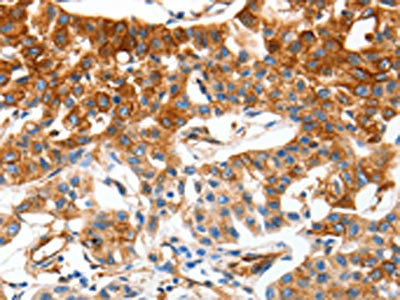CD146 antibody [P1H12]
GTX11372
ApplicationsFlow Cytometry, ImmunoFluorescence, ImmunoPrecipitation, ELISA, ImmunoCytoChemistry, ImmunoHistoChemistry, ImmunoHistoChemistry Frozen
Product group Antibodies
TargetMCAM
Overview
- SupplierGeneTex
- Product NameCD146 antibody [P1H12]
- Delivery Days Customer9
- ApplicationsFlow Cytometry, ImmunoFluorescence, ImmunoPrecipitation, ELISA, ImmunoCytoChemistry, ImmunoHistoChemistry, ImmunoHistoChemistry Frozen
- CertificationResearch Use Only
- ClonalityMonoclonal
- Clone IDP1H12
- ConjugateUnconjugated
- Gene ID4162
- Target nameMCAM
- Target descriptionmelanoma cell adhesion molecule
- Target synonymsCD146, HEMCAM, METCAM, MUC18, MelCAM, cell surface glycoprotein MUC18, Gicerin, S-endo 1 endothelial-associated antigen, cell surface glycoprotein P1H12, melanoma adhesion molecule, melanoma-associated antigen A32, melanoma-associated antigen MUC18
- HostMouse
- IsotypeIgG1
- Protein IDP43121
- Protein NameCell surface glycoprotein MUC18
- Scientific DescriptionCD146 (also known as A32, MCAM, Mel-CAM, MUC18, and S-Endo-1) belongs to the immunoglobulin supergene family with five immunoglobulin-like domains (V-V-C2-C2-C2), a transmembrane region and a 63 residue cytoplasmic tail. The protein is a membrane glycoprotein that functions as a Ca2+ independent cell adhesion molecule involved in heterophilic cell-cell interactions. CD146 has a molecular size of 130 kDa in its reduced form (118 kDa unreduced), and N-linked glycosylation accounts for fifty percent of the apparent molecular weight. In some cells the molecule carries a sulfate-3-glucuronyl moiety. Expression of the molecule was shown in a relatively limited spectrum of normal human tissues (endothelium, smooth muscle, and subpopulations of activated T cells) and malignant neoplasm (melanoma and breast carcinoma). The lineage specific expression pattern of CD146 can be useful in the differential diagnosis of certain lesions including melanomas and various types of gestational trophoblastic lesions. CD146 expression can promote tumor progression in human melanoma, through enhanced interaction between melanoma cells and endothelial cells. However, in breast carcinoma, CD146 may act as a tumor suppressor. Overexpression of CD146 in breast carcinoma cells results in a more cohesive cell growth and in the formation of smaller tumors in nude mice. During implantation and placentation, CD146 is expressed by the intermediate trophoblast in the placental site and binds to its putative receptor in uterine smooth muscle cells thus limiting trophoblastic invasion in the myometrium. Monoclonal antibody specific for CD146 is an important tool for the identification and isolation of cells expressing CD146.
- Storage Instruction-20°C or -80°C,2°C to 8°C
- UNSPSC12352203




![IHC-P analysis of human tonsil tissue using GTX34458 CD146 antibody [MCAM/1101].](https://www.genetex.com/upload/website/prouct_img/normal/GTX34458/GTX34458_20200115_IHC-P_1379_w_23060801_580.webp)
![IHC-P analysis of human melanoma tissue using GTX34459 CD146 antibody [SPM620].](https://www.genetex.com/upload/website/prouct_img/normal/GTX34459/GTX34459_20200115_IHC-P_756_w_23060801_248.webp)
![IHC-P analysis of human tonsil tissue using GTX34460 CD146 antibody [C146/634].](https://www.genetex.com/upload/website/prouct_img/normal/GTX34460/GTX34460_20200115_IHC-P_1287_w_23060801_842.webp)
